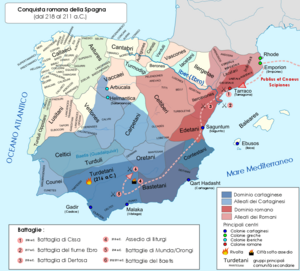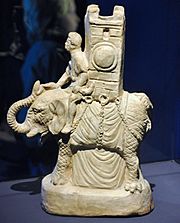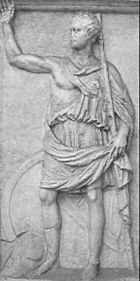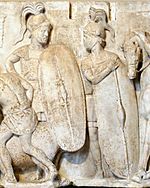Battle of Ibera facts for kids
Quick facts for kids Battle of Ibera |
|||||||
|---|---|---|---|---|---|---|---|
| Part of the Second Punic War | |||||||
 |
|||||||
|
|||||||
| Belligerents | |||||||
| Rome | |||||||
| Commanders and leaders | |||||||
| Gnaeus Cornelius Scipio Publius Cornelius Scipio |
|||||||
| Strength | |||||||
| Unknown; approximately 25,000 | Unknown; approximately 25,000 Included war elephants |
||||||
| Casualties and losses | |||||||
| Heavy | Heavy | ||||||
The Battle of Ibera, also known as the Battle of Dertosa, was a big fight during the Second Punic War. It happened in the spring of 215 BC near the Ebro River in what is now Tortosa, Spain. A Roman army, led by the brothers Gnaeus and Publius Scipio, beat a similar-sized Carthaginian army led by Hasdrubal Barca.
The Romans had arrived in Iberia (modern Spain) in late 218 BC. They won a battle called the Battle of Cissa and set up a base. This base, on the north-east coast, stopped any extra soldiers from Iberia from joining Hannibal. Hannibal was a famous Carthaginian general who had invaded Italy earlier that year. Hasdrubal tried to kick the Romans out in 217 BC, but his navy was defeated at the Battle of Ebro River.
Hasdrubal spent the next two years calming down local Iberian tribes who were rebelling. He got more soldiers and marched north again in early 215 BC. The Scipio brothers also got more soldiers. They crossed the Ebro River to attack Ibera, a town allied with Carthage. Hasdrubal came to fight, and the Scipios accepted. Both armies had about 25,000 soldiers. During the battle, the middle part of Hasdrubal's army, made of local Iberians, ran away without fighting. The Roman legions pushed through this gap. They then turned and attacked the remaining Carthaginian soldiers from the sides. Both armies lost many soldiers, but the Carthaginians lost a lot more. The Romans took over the Carthaginian camp, but Hasdrubal escaped with most of his cavalry.
The Scipio brothers kept working to control the Iberian tribes and attack Carthaginian areas. Hasdrubal lost his chance to send help to Hannibal in Italy. An army that was ready to sail to Italy had to go to Iberia instead. Because of this, some historians think the Scipios' victory was a very important battle in the war.
Contents
How We Know About the Battle
Most of what we know about the Punic Wars comes from an ancient Greek historian named Polybius. He lived from about 200 BC to 118 BC. He wrote a book called The Histories. Modern historians usually trust what Polybius wrote.
Sadly, Polybius's detailed story of the Battle of Ibera is lost. Another Roman historian, Livy, wrote about it. Livy often used Polybius's writings. However, some modern historians think Livy's battle descriptions are not always correct. Besides these old books, we also learn from ancient coins, writings carved in stone, and things found by archaeologists.
Why the Battle Happened
Before the War Started
The First Punic War was a long fight between Carthage and Rome. They were the two biggest powers in the western Mediterranean Sea. They fought for control, mostly around the island of Sicily and in North Africa. This war lasted 23 years, from 264 to 241 BC, and Carthage lost.
After the war, Carthage had to leave Sicily and pay a large amount of silver to Rome. A few years later, Rome unfairly took the islands of Sardinia and Corsica from Carthage. They also demanded more silver. This made Carthage very angry. Polybius believed this unfair act by Rome was the main reason the war started again 19 years later.
Soon after, a Carthaginian general named Hamilcar Barca went to expand Carthage's land in south-east Iberia (modern Spain and Portugal). This area became like a private kingdom for his family. Carthage gained silver mines, rich farmland, and more soldiers. This made them stronger against Rome. Hamilcar was followed by his son-in-law, Hasdrubal, and then his son, Hannibal, in 221 BC.
In 226 BC, Rome and Carthage agreed to the Ebro Treaty. This treaty said the Ebro River would be the northern border for Carthage's influence. But Rome later made a separate agreement with the city of Saguntum, which was south of the Ebro. In 219 BC, Hannibal attacked and captured Saguntum. In spring 218 BC, Rome declared war on Carthage, starting the Second Punic War.
Hannibal Invades Italy
In 218 BC, Rome prepared an army to fight in Iberia. It was led by the Scipio brothers, Gnaeus and Publius. But some Gauls (people from ancient France and northern Italy) attacked the Romans in northern Italy. The Roman Senate had to send some soldiers meant for Iberia to fight the Gauls instead. So, the Scipios had to get new soldiers, which delayed their trip to Iberia until September.
Meanwhile, Hannibal gathered his Carthaginian army and marched through Gaul. He took a route away from Rome's allies on the coast. Hannibal left his brother Hasdrubal Barca in charge of Carthage's lands in Iberia. The Roman fleet carrying the Scipio brothers' army landed near modern Marseille at the same time Hannibal was crossing the Rhone River. Hannibal avoided the Romans. Gnaeus Scipio continued to Iberia with his army, while Publius went back to Rome. Hannibal's army crossed the Alps mountains in early 217 BC. This surprised the Romans and made them cancel their plan to invade Africa that year.
Rome Fights in Iberia
Gnaeus Scipio went from Marseille to Iberia. In autumn 218 BC, he landed his army of about 25,000 soldiers at Cissa. He gained support from local tribes. The Carthaginian commander there, Hanno, attacked Scipio at the Battle of Cissa and lost.
In 217 BC, the Carthaginians tried to fight the Roman navy at the Battle of Ebro River. Hasdrubal worked with a fleet of 40 Carthaginian ships. But the Roman fleet defeated them, and 29 Carthaginian ships were lost. After this, the Carthaginian forces pulled back. The Romans stayed in the area between the Ebro River and the Pyrenees mountains. This Roman presence stopped Carthage from sending soldiers from Iberia to help Hannibal in Italy.
Because Carthage was losing, some Iberian tribes turned against them. While Hasdrubal was dealing with these rebellions, Gnaeus Scipio got 8,000 more soldiers in 217 BC. These were led by his brother Publius Scipio. Hasdrubal then got orders from Carthage to go to Italy and join Hannibal. But Hasdrubal said he couldn't leave because the Spanish tribes were still too rebellious. In 217 BC, he received 4,500 more soldiers from Africa. In 216 BC, he got a whole new army. This showed that the local Iberians were not very enthusiastic about fighting for Carthage.
Getting Ready for Battle
After calming the rebellious tribes, Hasdrubal left a commander named Himilco in charge at Cartagena. He marched north with his army in early 215 BC. He wanted to fight the Romans and secure Spain before going to Italy.
The Romans crossed the Ebro River with a large force. They started to attack Ibera, a small town allied with Carthage. Hasdrubal then attacked a town allied with Rome. So, the Scipios stopped their attack on Ibera and moved to fight Hasdrubal.
The Armies
Roman Army
Most Roman men had to serve in the army as foot soldiers. Richer men served as cavalry (soldiers on horseback). Usually, Rome would raise two legions for war. Each legion had about 4,200 foot soldiers and 300 cavalry. About 1,200 of the foot soldiers were poorer or younger men. They were called velites and used javelins (throwing spears) and short swords. The rest were heavy infantry. They wore armor, carried large shields, and used short swords. They fought in three lines.
Each year, Rome elected two leaders called consuls to lead armies. An army usually had one Roman legion and one similar legion from their Latin allies. Allied legions often had more cavalry than Roman ones.
We don't know the exact setup of the Roman army at Ibera. But it's thought to have been about 25,000 soldiers. This probably included two Roman legions, two allied legions, their cavalry, and some local Iberian soldiers. It was likely about the same size as the Carthaginian army.
Carthaginian Army
Carthage usually hired soldiers from other countries. Many came from North Africa. These included heavy foot soldiers with large shields and spears, light foot soldiers who threw javelins, heavy cavalry with spears, and light cavalry who threw javelins from a distance. Iberia also provided many experienced foot soldiers. They were unarmored and charged fiercely, but sometimes ran away if the fight lasted too long.
Sometimes, citizens from Carthaginian cities would join the army. They fought like the North African heavy foot soldiers. These soldiers often fought in a tight formation called a phalanx. Soldiers from the Balearic Islands were often hired as slingers. The Carthaginians also used war elephants. These were African forest elephants, smaller than today's African bush elephants. We don't know if they carried towers with fighters on their backs.
The exact setup of the Carthaginian army at Ibera is not fully known. But it's estimated to have been around 25,000 soldiers, similar in size to the Roman army. The Carthaginian army also had a small number of war elephants, perhaps the 21 elephants Hannibal had left in Iberia.
The Battle Itself
Setting Up the Armies
Before a big battle, armies would often camp a few miles apart for days or weeks. Either commander could choose not to fight. Setting up the armies for battle was a complex process that took several hours. Foot soldiers were usually in the middle of the battle line. Light foot soldiers (skirmishers) were in front, and cavalry was on the sides. Many battles were won when one army's foot soldiers were attacked from the side or behind.
At Ibera, the two armies set up camps about 5 miles (8 km) from each other on a plain. For several days, they only sent out small groups of skirmishers. Finally, both armies marched out and got ready to fight on the same day.
The Romans set up their troops in their usual way. This probably meant two Roman legions were side-by-side in the middle. One Italian allied legion was on each side of them. Each legion sent its javelin-throwers out front. The cavalry was split and placed on each side.
Hasdrubal put his unarmored Iberian foot soldiers in the middle of his line. African heavy foot soldiers were on their left, and other heavy foot soldiers (called "Poeni") were on their right. Both the Africans and Poeni would have fought in a dense phalanx formation. Libyan and Iberian cavalry were on the left side, facing the Roman cavalry. Numidian light cavalry were on the right side, facing the Italian allied cavalry. The elephants were probably placed in front of the foot soldiers. The slingers and light foot soldiers formed a line in front of the elephants.
The Fight Begins

Livy's account doesn't give many details about the battle. For example, it doesn't say what effect the elephants had. At the Battle of Tunis in 255 BC, 100 Carthaginian elephants caused a lot of trouble for Roman soldiers. But at Ibera, there were only about 20 elephants. Maybe there weren't enough to scare the Roman soldiers.
However the elephants were handled, the two Roman legions in the middle moved forward against the Iberian foot soldiers. The skirmishers from both sides threw their weapons and then went behind their main armies. The front line of the Roman legions and the Iberians also threw javelins and then moved closer to fight. But the Iberians couldn't stand up to the Roman attack. They quickly ran away. Livy says the Iberians knew that if they won, they would have to march to Italy with Hasdrubal's army. They didn't want to leave Iberia, which made them not want to fight hard.
On both sides of the armies, the cavalry fought in a back-and-forth skirmish. Neither side gained a clear advantage. Meanwhile, the strong groups of North African and Poeni heavy foot soldiers on either side of the Iberians partly turned and attacked the sides of the two Roman legions. But these Carthaginians also had an allied Roman legion in front of them.
The Roman legions stayed disciplined. They didn't chase the fleeing Iberians. Instead, they turned to attack the backs of the two Carthaginian units. Trapped from all sides, the Carthaginians were in a hopeless situation. The Libyan foot soldiers fought hard, causing and taking many losses, before they were defeated. The Carthaginian cavalry and their elephants ran away from the battle, having lost few soldiers. The Romans then attacked and took everything from the Carthaginian camp, including their supplies, equipment, and money.
What Happened Next
We don't know exactly how many soldiers each side lost. Some historians say the Carthaginians were almost completely wiped out. But Livy's numbers for Carthaginian losses in other battles are often much higher than what Polybius reported. So, Livy's numbers might be too high. Hasdrubal survived the battle with most of his elephants and cavalry, and some foot soldiers (mostly Iberians). Ibera probably surrendered to the Romans after the battle. The defeated Carthaginian army went back to Cartagena. This left the Romans firmly in control of north-east Iberia and blocked the land route to Italy.
The Scipio brothers didn't immediately launch another big attack against the Carthaginians. They continued their strategy of raiding and encouraging Iberian tribes to rebel. This was partly because the Battle of Cannae, a terrible defeat for the Romans, happened in Italy around the same time. For several years, Rome focused its soldiers and resources on protecting its homeland, leaving little for Iberia. The Scipios even complained to the Roman Senate about not getting enough help. They would continue fighting in Iberia until 212 BC, when they were both killed in another big Roman defeat.
Why This Battle Was Important
The Scipios' victory meant that Carthage couldn't send soldiers to Hannibal by land. It also stopped expected reinforcements by sea. And it weakened Carthage's control over the Iberian tribes. Hannibal's youngest brother, Mago, had gone to Italy with him in 218 BC. He was sent back to Carthage to gather more soldiers. He raised an army that was supposed to land in Italy in 215 BC. But after the Carthaginian defeat at Ibera, this army was sent to Iberia instead.
Some historians believe that the Roman victory prevented them from being kicked out of Iberia. It also stopped Hasdrubal from marching with a full army to help Hannibal in Italy. If Hasdrubal had joined Hannibal, Rome might not have been able to fight both of them. Because of this, some historians, like Klaus Zimmermann, say that "the Scipios' victory... may well have been the decisive battle of the war."
Images for kids
See also
 In Spanish: Batalla de Dertosa para niños
In Spanish: Batalla de Dertosa para niños






